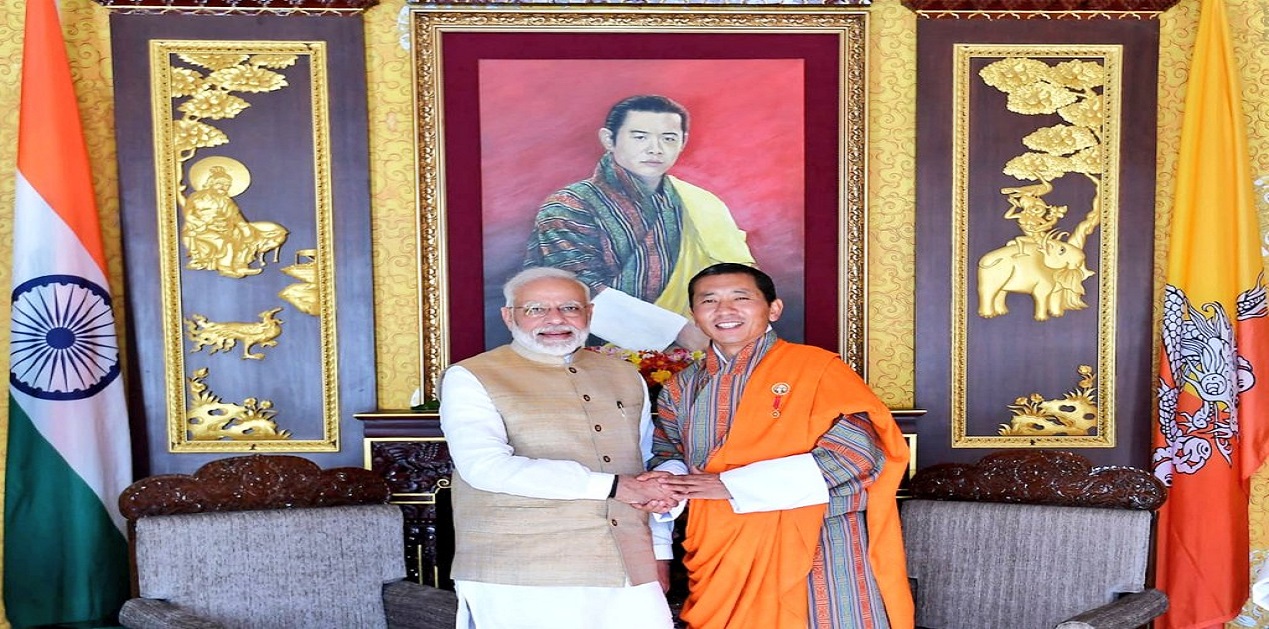India and Bhutan share a very close relationship not only in terms of geography but also in terms of history, traditions, culture and spirituality. The relationship between India-Bhutan runs very deep and there are regular high-level visits between both the countries. Prime Minister Narendra Modi’s recent two-day visit (17-18th August) was in line with the tradition.
This was an important visit as PM Modi inaugurated the 720 MW power Mangdechhu hydro-power project. He also launched stamps to commemorate the 50 years of Indo-Bhutan hydropower cooperation. With the inauguration of this project, the hydropower capacity of Bhutan crossed 2000 MW.1 This dam is one of the 10 hydropower projects which is covered under the 2006 agreement on cooperation in hydropower between Royal Government of Bhutan’s initiative to generate 10,000 MW hydropower by the year 2020 with support from the Indian government. 2 Hydropower has been the bedrock of India-Bhutan relationship but there has been a demand in Bhutan to diversify the relations with India beyond hydropower and the current ruling party Druk Nyamrup Tshogpa (DNT) had mentioned about it in their manifesto. 3
In his previous visit in 2014, PM Modi had suggested that India and Bhutan develop partnerships in the areas of tourism, sports and scholarships to reinforce Bharat to Bhutan (B2B) partnership. This visit reflected India attempt to diversify its relationship with Bhutan and move beyond hydropower. In his speech at Royal Bhutan University, he said that both countries are seeking to cooperate extensively in new frontiers from school to space, digital payments to disaster management.
During the visit, 10 memoranda of understanding (MOU) were signed. Majority of these MOUs were signed in the areas of knowledge sharing and technological cooperation. PM Modi highlighted how education has been central to the relationship of these two neighbours from ancient times and Buddhist teachers and scholars formed the bridge of learning between India and Bhutan. MOUs were signed in various fields such as power, aviation, IT, education and research. Out of the total 10 MOUs, seven were in the field of education and only one related to hydropower. Five MOUs were signed between the Universities of Bhutan and India.4 This shows the centrality of knowledge sharing and focuses on enhancing people to people contacts between the two nations. PM Modi in his address at the Royal University of Bhutan said that people are at the centre of this relationship and it is the people who are the real source of power and energy in India-Bhutan relationship. The MOUs signed by Universities of Bhutan with Indian universities will help the youth of Bhutan have access to high-quality education. The MOU signed between National Knowledge Network of India (NKN) and Druk Research and Education Network on Peering agreement will connect the students of Bhutan to the various E-learning platform. Sri Lanka and Bangladesh are already connected to NKN.
The signing of several of the MOUs in the education sector will lead to opening up of new frontiers of cooperation in the bilateral relationship. Education and technology are very important sectors for Bhutan. The median age of Bhutan’s population is 26.9 years which means that half of the country’s population is less than 27 years.5 The signing of MOUs with National Knowledge Network and Indian universities will give help in connecting the scholars and academic between both the countries which will help the quality of education for Bhutanese students. At present 4,000 students from Bhutan are studying in India and PM Modi emphasized that this number should grow.6 Indian help in enhancing the quality of education in Bhutan will lead to further deepening of the relationship between the two countries. India also increased the post-graduate scholarship from two to five for Bhutanese students at Nalanda University.
This century will be driven by technology and technology will play a major role in this century. Technology becomes more important for a country like Bhutan which is landlocked and has limited natural resources. It can support Bhutan in harnessing natural resources more effectively and help in higher productivity. Bhutan’s King in his last address at the Royal Bhutan University had asked students to find out ways to use technology to solve problems to enhance governance, democracy, education, create jobs. The signing of the MOU between Indian Space and Research Organisation (ISRO), India and Department of Information Technology and Telecom (DITT), and Bhutan on the establishment of SATCOM network for utilisation of South Asia satellite can be termed as a good move in the right direction.7 This agreement will help in boosting technological cooperation. The inauguration of the ground station of the South Asian satellite at Thimphu is a positive step towards Bhutan space cooperation. The satellite will connect all the 20 Dzongkha or districts and some villages of Bhutan. It will provide better services such as net banking, e-governance, telemedicine, distance education, weather forecast and early warning system for disaster management.
During the visit, PM Modi also focused on boosting Bhutan’s financial sector and tried to infuse technological advancement in this sector. The RuPay card was launched, Bhutan is the second country where this card has been launched after Singapore. This card will help in boosting digital payments between both countries and also aid in trade and tourism sector. It will also help in further integration of economies of both countries. The feasibility study for the use of India’s Bharat Interface for Money (BHIM) app in Bhutan was also agreed to promote cashless payment between the two countries. PM Modi promised PM Dr. Tshering of a positive consideration on Bhutan’s request for enhancement of currency swap limit under SAARC Currency Swap Framework and provided an additional US$ 100 million currency as an interim measure to meet the foreign exchange requirement.8
India also promised to increase the Liquified Petroleum Gas (LPG) supply to Bhutan from 700 to 1000 MT per month as this will increase the reach of clean fuel to people of Bhutan especially the villages. PM Modi congratulated the people and the government of Bhutan for the country’s successful graduation to the category of Middle-Income category and simultaneously also preserving their heritage and environment. Bhutanese PM Dr. Tshering also commended PM Modi for his strong and dynamic leadership and said, “A politically and economically stable and successful India translates to a more prosperous region that will also benefit Bhutan.”9
Bhutan is a major partner in India’s ‘Neighbourhood First’ policy and India appreciated the importance of Bhutan and its geographical location. The geography of Bhutan makes it susceptible to the problem of climate change which can impact the economy of Bhutan and the livelihood its people. This is the reason that now India is working towards diversifying from the hydropower sectors. Also, hydropower is not an employment generation industry in Bhutan as it doesn’t have the skilled labour for the industry. The problem of youth unemployment is growing in Bhutan. The youth unemployment in Bhutan has grown from 9.4 percent in 2014 to 13.2 percent in 2016.10 The signing of MOU in the sectors of education and technology will help in boosting the skills of the youth in Bhutan and generate more employment opportunities which in turn will benefit the economy of Bhutan.
This visit of PM Modi soon after his second electoral win was a timely one and will go a long way in deepening the bilateral relationship between both the countries.
Endnotes
- https://www.mea.gov.in/bilateral-documents.htm?dtl/31739/Joint_Statement_on_the_State_Visit_of_Prime_Minister_of_India_to_Bhutan
- http://pib.gov.in/newsite/PrintRelease.aspx?relid=77616
- DRUK NYAMRUP TSHOGPA MANIFESTO 2018, P.23 http://www.druknyamrup.info/manifestos/
- https://www.mea.gov.in/bilateral-documents.htm?dtl/31733/list+of+mouagreement+exchanged+during+the+state+visit+of+prime+minister+to+bhutan
- http://www.kuenselonline.com/bhutans-population-is-735553/
- https://www.mea.gov.in/Speeches-Statements.htm?dtl/31737/Address_by_Prime_Minister_at_Royal_University_of_Bhutan_during_his_State_Visit_to_Bhutan_August_18_2019
- https://www.mea.gov.in/bilateral-documents.htm?dtl/31733/list+of+mouagreement+exchanged+during+the+state+visit+of+prime+minister+to+bhutan
- https://www.mea.gov.in/bilateral-documents.htm?dtl/31739/Joint_Statement_on_the_State_Visit_of_Prime_Minister_of_India_to_Bhutan
- http://www.kuenselonline.com/lyonchhen-thanks-pm-modi-for-visiting-bhutan/
- Statistical Yearbook of Bhutan 2018
(The paper is the author’s individual scholastic articulation. The author certifies that the article/paper is original in content, unpublished and it has not been submitted for publication/web upload elsewhere, and that the facts and figures quoted are duly referenced, as needed, and are believed to be correct). (The paper does not necessarily represent the organisational stance... More >>
Image Source: https://pbs.twimg.com/media/ECKpycRVAAE8kl_?format=jpg&name=medium











Post new comment